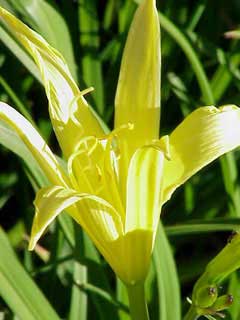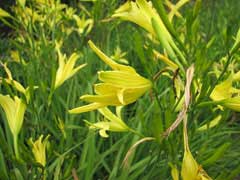 |
|
biolib.de |
 |
| http://commons.wikimedia.org/wiki/User:Pryma |
Translate this page:
Summary
Physical Characteristics

 Hemerocallis_citrina is a PERENNIAL growing to 0.8 m (2ft 7in) by 0.8 m (2ft 7in).
Hemerocallis_citrina is a PERENNIAL growing to 0.8 m (2ft 7in) by 0.8 m (2ft 7in).
See above for USDA hardiness. It is hardy to UK zone 4 and is not frost tender. It is in flower from June to July. The species is hermaphrodite (has both male and female organs) and is pollinated by Insects. The plant is not self-fertile.
Suitable for: light (sandy), medium (loamy) and heavy (clay) soils and can grow in heavy clay soil. Suitable pH: mildly acid, neutral and basic (mildly alkaline) soils. It can grow in semi-shade (light woodland) or no shade. It prefers dry or moist soil.
UK Hardiness Map
US Hardiness Map
Synonyms
H. baroni.
Plant Habitats
Edible Uses
Leaves and young shoots - cooked[205]. They must be consumed when very young or else they become fibrous[K]. Flowers and flower buds - raw or cooked[105, 177]. The flowers can be dried and used as a thickener in soups etc. The slender trumpets vary from 12 - 17cm long[205]. There can be from 7 to 65 buds on a flowering stem[205]. The flower buds contain about 43mg vitamin C per 100g, 983 IU vitamin A and 3.1% protein[205]. Root - raw or cooked[205]. The flavour is somewhat radish-like but not so sharp[205].
References More on Edible Uses
Medicinal Uses
Plants For A Future can not take any responsibility for any adverse effects from the use of plants. Always seek advice from a professional before using a plant medicinally.
The juice of the roots is an effective antidote in cases of arsenic poisoning[205]. A tea made from the boiled roots is used as a diuretic[205].
References More on Medicinal Uses
The Bookshop: Edible Plant Books
Our Latest books on Perennial Plants For Food Forests and Permaculture Gardens in paperback or digital formats.

Edible Tropical Plants
Food Forest Plants for Hotter Conditions: 250+ Plants For Tropical Food Forests & Permaculture Gardens.
More

Edible Temperate Plants
Plants for Your Food Forest: 500 Plants for Temperate Food Forests & Permaculture Gardens.
More

More Books
PFAF have eight books available in paperback and digital formats. Browse the shop for more information.
Shop Now
Other Uses
The tough dried foliage is plaited into cord and used for making footwear[205].
Special Uses
References More on Other Uses
Cultivation details
Succeeds in most soils[1], including dry ones, preferring a rich moist soil[200]. Grows well in heavy clay soils. Succeeding in sun or shade, it produces more flowers in a sunny position though these flowers can be shorter-lived in very sunny positions[205]. Succeeds in short grass if the soil is moist[1]. Prefers a pH between 6 and 7[200]. Plants are hardy to at least -20°c[187]. Widely cultivated in China for its edible flowers, especially in Hunan province[266]. Hybridizes freely with other members of this genus[200]. This species is said to be self-incompatible[127, 205]. Many of the plants in cultivation under this name are H. thunbergii[205]. The sub-species H. citrina vespertina (Hara.)Erhardt. is a very free-flowering form, producing up to 75 buds per scape and capable of flowering from July to October if the weather is suitable[205]. The plant forms a loose spreading clump[K]. The roots form pseudobulbs[205]. Plants take a year or two to become established after being moved[1]. Plants seem to be immune to the predations of rabbits[233]. The plants are very susceptible to slug and snail damage, the young growth in spring is especially at risk[200]. Individual flowers are very short-lived, they open in the late afternoon and die in the morning[200]. However, plants produce a succession of flowers for several weeks of the summer. The number of flowers on a scape varies from 7 to 65[205]. The flowers have a lemony scent[205]. Another report says that they have a pronounced honeysuckle scent[245].
References Carbon Farming Information and Carbon Sequestration Information
Temperature Converter
Type a value in the Celsius field to convert the value to Fahrenheit:
Fahrenheit:
The PFAF Bookshop
Plants For A Future have a number of books available in paperback and digital form. Book titles include Edible Plants, Edible Perennials, Edible Trees,Edible Shrubs, Woodland Gardening, and Temperate Food Forest Plants. Our new book is Food Forest Plants For Hotter Conditions (Tropical and Sub-Tropical).
Shop Now
Plant Propagation
Seed - sow in the middle of spring in a greenhouse. Germination is usually fairly rapid and good. Prick out the seedlings into individual pots when they are large enough to handle. Grow the plants on for their first winter in a greenhouse and plant out in late spring[K]. Division in spring or after flowering in late summer or autumn[200]. Division is very quick and easy, succeeding at almost any time of the year[K]. Larger clumps can be replanted direct into their permanent positions, though it is best to pot up smaller clumps and grow them on in a cold frame until they are rooting well. Plant them out in the spring.
Other Names
If available other names are mentioned here
Native Range
TEMPERATE ASIA: China (Anhui Sheng, Hebei Sheng, Henan Sheng, Hubei Sheng, Hunan Sheng, Jiangsu Sheng, Jiangxi Sheng, Nei Mongol Zizhiqu, Shaanxi Sheng, Shandong Sheng, Sichuan Sheng, Zhejiang Sheng), Korea, Japan (Honshu, Kyushu, Shikoku)
Weed Potential
Right plant wrong place. We are currently updating this section.
Please note that a plant may be invasive in one area but may not in your area so it’s worth checking.
Conservation Status
IUCN Red List of Threatened Plants Status :

Growth: S = slow M = medium F = fast. Soil: L = light (sandy) M = medium H = heavy (clay). pH: A = acid N = neutral B = basic (alkaline). Shade: F = full shade S = semi-shade N = no shade. Moisture: D = dry M = Moist We = wet Wa = water.
Expert comment
Author
Baroni.
Botanical References
200266
Links / References
For a list of references used on this page please go here
Readers comment